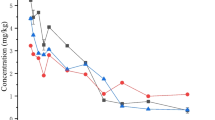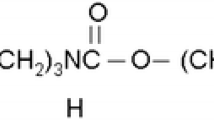Abstract
The dissipation and terminal residues of a fungicide suspension (5 % hexaconazole, 25 % kresoxim-methyl) in ginseng and soil were investigated by high-performance liquid chromatography coupled with tandem mass spectrometry (HPLC-MS/MS). At fortified levels of 0.01, 0.02, and 0.20 mg kg−1, the recoveries of hexaconazole and kresoxim-methyl were in the range of 80.6∼94.8 % and 82.4∼98.8 % with relative standard deviation of 3.42–9.12 % and 3.19–8.58 %, respectively. The half-lives were 7.09–10.73 days in root, 6.80–7.95 days in stem, 5.31–8.49 days in leaf, and 6.30–7.97 days in soil. The terminal residues were all below the maximum residue limits (MRLs) of EU and South Korea. Risk assessment results indicated that the risk of hexaconazole and kresoxim-methyl use in ginseng at dosage of 60–90 g a.i. ha−1 was negligible to humans. This work would help the government to establish the MRL and provide guidance on the proper and safe use of hexaconazole and kresoxim-methyl in ginseng.



Similar content being viewed by others
References
Attele, A. S., Wu, J. A., & Yuan, C. S. (1999). Ginseng pharmacology: multiple constituents and multiple actions. Biochemical Pharmacology, 58(11), 1685–1693.
Cabras, P., Angioni, A., Garau, V. L., Pirisi, F. M., & Brandolini, V. (1998). Gas chromatographic determination of azoxystrobin, fluazinam, kresoxim-methyl, mepanipyrim, and tetraconazole in grapes, must, and wine. Journal of AOAC International, 81(6), 1185–1189.
Choi, J., El-Aty, A. A., Park, Y., Cho, S., & Shim, J. (2007). The assessment of carbendazim, cyazofamid, diethofencarb and pyrimethanil residue levels in P. ginseng (C. A. Meyer) by HPLC. Bulletin of the Korean Chemical Society, 28(3), 369–372.
de Melo Abreu, S., Caboni, P., Cabras, P., Garau, V. L., & Alves, A. (2006). Validation and global uncertainty of a liquid chromatographic with diode array detection method for the screening of azoxystrobin, kresoxim-methyl, trifloxystrobin, famoxadone, pyraclostrobin and fenamidone in grapes and wine. Analytica Chimica Acta, 573(9), 291–297.
Deng, Z., Hu, J., Qin, D., & Li, H. (2010). Simultaneous analysis of hexaconazole, myclobutanil, and tebuconazole residues in apples and soil by SPE clean-up and GC with nitrogen–phosphorus detection. Chromatographia, 71(7–8), 679–684.
European Commission (2012). Pesticide EU-MRLs Regulation (EU) No. 899/2012. http://ec.europa.eu/sanco_pesticides/public/index.cfm?event=substance.historic.
European Commission (2013). Pesticide EU-MRLs Regulation (EU) No. 212/2013. http://ec.europa.eu/sanco_pesticides/public/index.cfm?event=substance.resultat&s=1.
Farajzadeh, M. A., Djozan, D., Nouri, N., Bamorowat, M., & Shalamzari, M. S. (2010). Coupling stir bar sorptive extraction-dispersive liquid-liquid microextraction for preconcentration of triazole pesticides from aqueous samples followed by GC-FID and GC-MS determinations. Journal of Separation Science, 33(12), 1816–1828.
Fenoll, J., Ruiz, E., Hellín, P., Navarro, S., & Flores, P. (2010). Solarization and biosolarization enhance fungicide dissipation in the soil. Chemosphere, 79(2), 216–220.
Fux, F., Wang, L. J., Zhao, P., Shang, X. Y., Sun, Y. Z., & Ye, M. J. (2012). Determination of hexaconazole in fruits and vegetables by gas chramtography tandem mass spectrometry. Food Science, 33(4), 227–229.
Grossmann, K., & Retzlaff, G. (1997). Bioregulatory effects of the fungicidal strobilurin kresoxim-methyl in wheat (Triticum aestivum). Pest Sci, 50, 11–20.
Ibrahim, W. A. W., Hermawan, D., Sanagi, M. M., & Aboul-Enein, H. Y. (2010). Stacking and sweeping in cyclodextrin-modified MEKC for chiral separation of hexaconazole, penconazole and myclobutanil. Chromatographia, 71(3–4), 305–309.
Jia, C., Zhu, X., Zhao, E., He, M., Yu, P., & Chen, L. (2013). Dissipation rates and final residues of kresoxim-methyl in strawberry and soil. Bulletin of Environmental Contamination and Toxicology, 90(2), 264–267.
Karthika, C., & Sachin, P. J. (2008). Gas chromatographic method for the determination of hexaconazole residues in black tea. J Zhejiang University SCIENCE B, 9(2), 160–164.
Kennedy, D. O., & Scholey, A. B. (2003). Ginseng: potential for the enhancement of cognitive performance and mood. Pharmacology, Biochemistry, and Behavior, 75(3), 687–700.
Kumar, V., Ravindranath, S. D., & Shanker, A. (2004). Fate of hexaconazole residues in tea and its behavior during brewing process. Chem Health and Safety, 11(1), 21–25.
Lee, T. K., Allison, R. R., Brien, K. F., Khazanie, P. G., Johnke, R. M., Brown, R., Blochd, R. M., Tate, M. L., Dobbs, L. J., & Kragel, P. J. (2004). Ginseng reduces the micronuclei yield in lymphocytes after irradiation. Mutation Research, 557(1), 75–84.
Li, W. X., Chen, M., Chen, W. T., Qiao, C. K., Li, M. H., & Han, L. J. (2012). Determination of mepiquat chloride in cotton crops and soil and its dissipation rates. Ecotoxicology and Environmental Safety, 85, 137–143.
Liang, H., Li, L., Li, W., Wu, Y., & Liu, F. (2012). The decline and residues of hexaconazole in tomato and soil. Environmental Monitoring and Assessment, 184(3), 1573–1579.
Liu, C. X., & Xiao, P. G. (1992). Recent advances on ginseng research in China. Journal of Ethnopharmacology, 36(1), 27–38.
Malhat, F., Kamel, E., Saber, A., Hassan, E., Youssef, A., Almaz, M., Hassan, A., & Fayz, A. (2013). Residues and dissipation of kresoxim methyl in apple under field condition. Food Chemistry, 140(1–2), 371–374.
Navalon, A., Prieto, A., Araujo, L., & Vilchez, J. L. (2002). Determination of pyrimethanil and kresoxim-methyl in green groceries by headspace solid-phase microextraction and gas chromatography–mass spectrometry. Journal of Chromatography A, 975(2), 355–360.
Shibata, S. (2001). Chemistry and cancer preventing activities of ginseng saponins and some related triterpenoid compounds. Journal of Korean Medical Science, 16(Suppl), 28–37.
Thurman, E. M., Ferrer, I., Zavitsanos, P., & Zweigenbaum, J. A. (2013). Analysis of isobaric pesticides in pepper with high-resolution liquid chromatography and mass spectrometry: complementary or redundant? Journal Agricultural and Food Chemistry, 61(10), 2340–2347.
Venkateswarlu, P., Rama Mohan, K., Ravi Kumar, C., & Seshaiah, K. (2007). Monitoring of multi-class pesticide residues in fresh grape samples using liquid chromatography with electrospray tandem mass spectrometry. Food Chemistry, 105(4), 1760–1766.
Vogler, B. K., Pittler, M. H., & Ernst, E. (1999). The efficacy of ginseng. A systematic review of randomised clinical trials. European Journal of Clinical Pharmacology, 55(8), 567–575.
Wang, C. Z., & Yuan, C. S. (2008). Potential role of ginseng in the treatment of colorectal cancer. The American Journal of Chinese Medicine, 36(6), 1019–1028.
Wang, W., Zhao, Y., Rayburn, E. R., Hill, D. L., Wang, H., & Zhang, R. (2007). In vitro anti-cancer activity and structure–activity relationships of natural products isolated from fruits of Panax ginseng. Cancer Chemotherapy and Pharmacology, 59(5), 589–601.
Yang, D. J., Wang, Z. T., Song, S. F., & Chen, B. (2008). Research on food additives limits of Chinese medicinal herb. Chin J Public Health, 24(3), 358–359.
Yun, T. K. (2001). Panax ginseng a non-organ-specific cancer preventive? The Lancet Oncology, 2(1), 49–55.
Acknowledgments
This work was supported by Agricultural Product Quality and Safety of World Bank Loan Project (No. 2011-Z24) and Special Fund for Ginseng Industrial Development of Jilin province in 2011.
Author information
Authors and Affiliations
Corresponding author
Additional information
Yan Wang and Chunwei Wang contributed equally to this study.
Rights and permissions
About this article
Cite this article
Wang, Y., Liu, C., Gao, J. et al. Dissipation behavior of hexaconazole and kresoxim-methyl residues in ginseng and soil under field conditions. Environ Monit Assess 187, 4126 (2015). https://doi.org/10.1007/s10661-014-4126-6
Received:
Accepted:
Published:
DOI: https://doi.org/10.1007/s10661-014-4126-6




